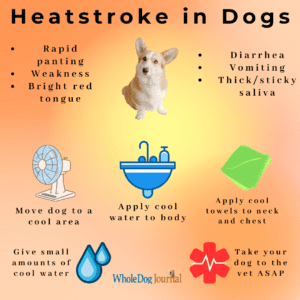
Most of us have heard a horrendous story about a dog suffering from heat stroke. Heat stroke can affect any dog in a situation that is too hot. These situations include sitting inside a non-air conditioned vehicle, laying outside in the sunshine on a hot summer day, or going for a walk or run when it is too hot and humid outdoors. Here are some common sense steps to avoid heat stroke in dogs, and how to treat acute heat stroke in a dog.
Signs of heat stroke in dogs
- Excessive panting. Dogs regulate their body temperature by panting, so it is normal for a dog to pant when he is warm. A dog who pants while hanging his head low, excessively drooling, walking slowly, and using his abdominal muscles to breathe is excessively panting.
- Red, blue, purple, or gray gums. Dogs experiencing heat stroke will initially have bright red gums. But as heat stroke progresses and the dog goes into shock, their gums will turn blue, purple, or gray.
- Lethargy, disorientation, and uncoordinated walking. A dog exhibiting these symptoms may be experiencing the advanced stages of heat stroke.
- Collapse, vomiting, or seizures are the signs of end-stage heat stroke.
How to treat acute heat stroke
Quick intervention is the key to helping a dog that is experiencing heat stroke:
-

Use this infographic to remember what to look out for if your dog is having a heatstroke and how to treat it. © Natasha Medvetsky Move the dog to a shady location that is well-ventilated.
- Pour cool water over the dog, making sure to avoid the face. Do not use cold water or ice water; this will cool a dog down too quickly and send him into shock.
- Do not apply cool or wet towels to the dog. Towels trap heat against the dog’s body, worsening the heat stroke condition.
- If available, place a fan near the dog so that air can move over his body. This will help the water on his body evaporate (which causes a reduction in the air temperature immediately next to the dog) and carry away excess heat.
- If the dog is alert and not collapsed, seizing, or disoriented, you may offer small amounts of cool water to drink. Do not syringe water into a dog’s mouth; doing so may result in aspiration pneumonia.
- Transport the dog to the nearest veterinary hospital. If the dog has collapsed, is vomiting, or is having seizures, do not delay in seeking veterinary attention.
Following these simple steps can help save the life of a dog experiencing heat stroke.





